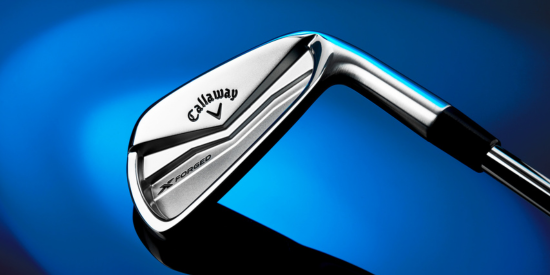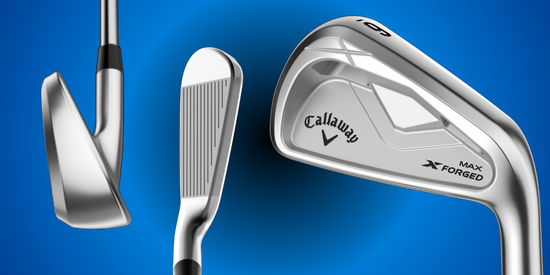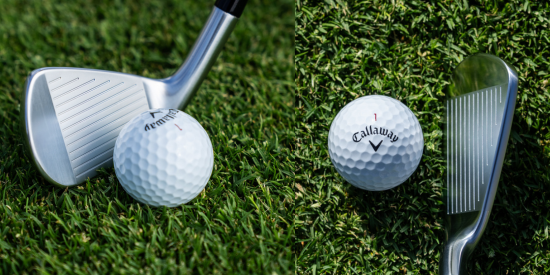What to Know
- Single-piece 1020 carbon steel forging for classic feel
- Two models: X Forged (compact, minimal offset) and X Forged Max (mid-compact, slightly more forgiving)
- Tri-Level Sole design for clean turf interaction in all conditions
- Traditional vs. slightly stronger lofts for desired launch windows
- Inspired by classic Japanese shaping and validated on Tour
- Ideal for better players, from Tour pros to low single-digit amateurs
At first glance, the 2025 Callaway X Forged and X Forged Max irons don’t shout for attention. There’s no flashy tungsten weighting story or complex multi-material construction. No injected polymer. Instead, they whisper: feel matters.
For elite players, that whisper can be deafening.
These irons are a return to the roots of players’ gear: single-piece forging, simple cavity designs, and shaping that doesn’t apologize for being demanding. But they're also smarter, subtly modern, and unmistakably Callaway.

Inspired by the Best in the World
Callaway didn’t invent this style of iron. In fact, they freely admit they went to school on the best.
These designs pay direct homage to the classic Japanese forgings that have set the standard for craftsmanship, shape, and feel for decades. Callaway’s iron team spent time in Japan studying local preferences—thin toplines, compact profiles, sole shapes that suit firm, tight lies—and tested prototypes with their JGTO and LPGA staff.
It's the same design philosophy that’s quietly shaped other Callaway categories, like the Odyssey Giraffe Beam putter line, which borrows heavily from Japanese "Neo-Mallet" shapes in both aesthetics and performance.
In other words, this isn’t a one-off. It’s a Callaway-wide recognition that Japanese-inspired design sells, performs, and connects with serious players everywhere.
“Our goal was to create the softest, best-feeling iron in the lineup—a true one-piece forged design that better players will love.”
– Ryan Ritchie, Callaway Irons R&D Manager
Two Irons. Two Purposes.
But these aren’t just copycat forgings. Callaway’s offering is purposefully split in two:
- X Forged: The pure, no-compromise players iron for tour-level ball strikers. Compact, minimal offset, thin topline, and classic lofts.
- X Forged Max: A more approachable players-distance sibling with subtle forgiveness, stronger lofts, and a mid-compact shape that gives elite amateurs confidence without sacrificing feel.
Both are single-piece forged from 1020 carbon steel. That matters. In a world of hollow-bodied "players distance" irons, a true single-piece forging remains the gold standard for consistent, soft impact feel and predictable ball flight.
| Feature | X Forged | X Forged Max |
|---|
| Construction | Single-piece 1020 carbon steel forging | Single-piece 1020 carbon steel forging |
| Shape | Compact, minimal offset, thin topline | Mid-compact, slightly larger profile |
| Lofts | Traditional (e.g. 7-iron ~33°) | Slightly stronger (e.g. 7-iron ~31°) |
| Forgiveness | Low—designed for precision players | Moderate—heel/toe pockets for forgiveness |
| Target Player | Tour pros, scratch, low single-digit | Mid to low single-digit amateurs |
| Sole Design | Tri-Level Sole for firm turf precision | Tri-Level Sole with wider width for easier turf interaction |
| Feel | Pure, crisp, ultra-responsive | Soft, with subtle added stability |
Technology That Stays Out of the Way
If you're looking for tech talking points to impress your buddies, these irons may seem quiet at first. But under the hood, there’s thoughtful engineering.
Both models feature a Tri-Level Sole—a subtle but crucial design Callaway developed originally for Japan’s tight, firm turf. It has a beveled leading edge to prevent digging, a cambered sole for smooth interaction, and trailing edge relief to exit the turf cleanly.

That design wasn't just for show. It worked so well in testing that Callaway migrated it across their iron lineup.
The Max model also uses smart cavity engineering: subtle heel and toe pockets remove unnecessary mass, lowering the center of gravity while keeping weight behind the strike zone. The result is forgiveness and high launch, with no sacrifice in feel.
Tested by Our Own
Equipment Panelist Blaire McKeithen, fresh off qualifying for events on the European mini-tour, spent weeks putting both models through their paces.
As an elite-level player with professional tournament experience, Blaire gravitates to classic blades but knows the demands of tournament travel—variable turf, fatigue over multi-round events—make forgiveness matter.
He found the standard X Forged ideal for firm links-style courses, where turf interaction and low, piercing flights matter. Meanwhile, the X Forged Max delivered confidence on tighter lies and softer parkland layouts, launching slightly higher with easier long-iron performance—key when you’re battling cold air and 200-yard par-3s.

Why This Matters
In an era where OEMs are obsessed with ball speed stories, Callaway is betting that serious players still value feel—and know the difference.
These irons are for the golfer who wants artistry, subtlety, and the chance to shape shots without surprise hot spots. They’re for those who understand why a slightly higher toe, thinner topline, and forged carbon steel aren’t marketing noise—they’re the difference between a scoring club and a liability.
Callaway didn’t just resurrect an old line. They modernized it, validated it on tour, and expanded it to suit a wider swath of elite amateurs.
The Final Take
If you’re the kind of player who wants your irons to do exactly what you tell them—no more, no less—these deserve a look.
If you’re ready to graduate from forgiving game-improvement models but don’t want to punish your score when you’re tired or off your game, the X Forged Max is your safety net with no compromise in feel.
Either way, Callaway’s new forged offerings prove that even in 2025, there’s nothing quite like the simplicity of a single-piece forged iron done right.